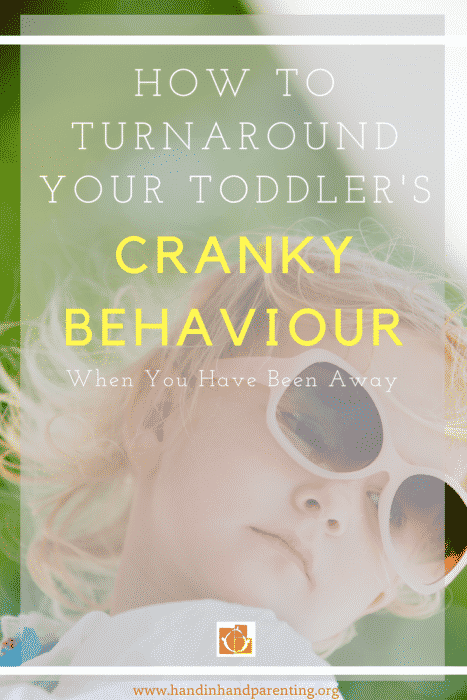![]()
 You've had a hard day and you walk through the door, ready to see your child and find out what you missed. Except that when you walk into your home, your son or daughter gives you a sour look.
You've had a hard day and you walk through the door, ready to see your child and find out what you missed. Except that when you walk into your home, your son or daughter gives you a sour look.
You take a deep breath. Instead of the happy homecoming you dreamt of and crave, it looks like you will be weathering the meltdown of a cranky toddler.
Trying to avoid that, you step a little closer to your child. You smile and make an attempt to placate them. “Hey, what's that you are doing? Did you make a new drawing.”
But this attempt at peace-keeping fails. Instead, you get a cold shoulder – or worse, a tongue stuck out at you, any kind of many rebuffs, and more crankiness. Pretty soon the whining starts, and then defiance. And while you are thinking about what you need to do to get dinner on the table or homework done, the meltdowns begin.
But, what if it doesn't have to be this way?
Take a Step Back: What's Behind the Cranky Behavior?
Hidden feelings of upset:
Who knows what happened when you were out? Maybe your child didn't nap as long. Maybe her toy broke. Maybe she couldn't get the tower she wanted to stack as high as she wanted to stack it. Even if the room looks peaceful when you walk in, there could be a backlog of feelings waiting to be heard.
Sensing Lost Connection:
Your child may have suddenly felt your loss more closely than usual today and is waiting to reconnect. The trouble is, separation can bring on feelings of doubt and loneliness and rejection, and children can have a hard time sorting through those feelings to find a bright way to show you he wants your attention now. This is not to say that you can't ever leave, but noticing when your child is more demanding, is also noticing that he or she needs a little more closeness and security.
Connecting Separation With Other Big Changes:
If there have been other big changes – your parents visited and now they have left, you were on vacation and now the regular daily routine is back in place, or perhaps a new sibling recently joined the family – your leaving can trigger the feelings your child has been holding onto about recent those upheavals.
How to Reconnect After Being Away
If you can take the perspective that, through clinginess and crankiness, whining or rejection, your child is, in their own way, showing you they want you close, how can you build a connection when they appear to be doing everything they can to keep you away?
One Secret Weapon to Bring Down The Barriers With a Cranky Toddler
 Laughter is a powerful thing and underestimated when it comes to bringing down tensions. Play helps children laugh their fears away.
Laughter is a powerful thing and underestimated when it comes to bringing down tensions. Play helps children laugh their fears away.
At times like these, it can look like the last thing your child wants to do is laugh, but if you give them the time and space they need, silliness and fun will often come to the rescue. Laughter may bring the lightness and brightness you need to reconnect.
Take a look at how Hand in Hand instructor Georgiana Bucatariu used a playful response when she returns home to a cranky three-year-old.
Using Play to Reach an Upset Child
“A few days ago I got home and my little princess was very cranky. Instead of giving me her usual kiss she asked me if I had a surprise for her. I said “No sweetie, not this time…” She started whining that she wanted a surprise and she told me that I never bring anything to her.
How A Child Signals They Need You
“In my mind, I thought ‘Hey?! Where is this coming from?' but I decided to listen and said, ‘Hey sweetie! I’m happy to be home with you! Would you like to do something together?'
“My attempt didn’t work!
“She replied ‘No! I want to be alone now. I’m upset.' (What a reply from a three and a half-year-old!)
I got closer to her and I said I wanted to be with her if she was upset. She then moved away and said she wanted to be alone in the other room. Although she started walking towards the other room, she kept looking at me. I followed, keeping a small distance and told her I wanted to be with her. She moved from one room to another as I kept following a short distance behind.
Laughter Breaks Through The Whining
“She started smiling a bit so I took a chance. ‘Hey girl, what are we doing here? We are playing like a cat and mouse!' I said.
“She started laughing and repeating what I said. She started running from room to room and laughing really hard saying, ‘What are we doing here, girl? We are playing like a cat and mouse!'
“I ran after her, exclaiming that she was a very fast mouse!
“She laughed really hard and so did I. We kept playing like that for a while.
“When we finished the game she was really happy! She kissed me and told me she was happy I came home, and after that, she was really relaxed.
“I’m not sure what the reason was behind her upset, and I don’t think it even matters. I’m really happy that I had the patience to listen and apply the tool of Playlistening to help my daughter through her upset.”
GoTo Toolkit for Sweeter Reunions
The next time you come home to a cranky toddler, try these four steps for a sweeter reunion.
Bring down your expectations. Going in expecting a happy reunion can make it harder when your child rebuffs your affection. Take a minute before you go inside to breathe and prepare yourself.
Don't take it personally. If your child is cranky, whining, or runs away from you, see those behaviors as a code language he or she saves for you. It means, “I need you more than ever right now.”
Go lightly. Don't insist on a big reunion. Follow your child's lead.
Look for the giggles. If you can stay calm you become the anchor for your child and his or her feelings. You become a safe place for them to show you what's going on. When they see you aren't angry they can relax too. When you follow their lead, look for opportunities to laugh. One Hand in Hand instructor plays the “Don't Laugh” game when she senses her child is ready. She says, “Tom is grumpy now. Whatever we do, no-one can laugh.” This often prompts her child to smile, and just that one action begins to lighten the mood.
Accept any invitation to play. When a child rips up his new drawing or thwacks a pillow to the side of your head, it can look and feel like he is testing the boundaries. But if all is safe, these interactions can be seen as invitations to connect. A winning way to respond is with play. When you respond to the ripping action by grabbing an old newspaper and saying, “Ripping looks like fun, I want to try. Oooh, that DOES feel good,” or taking that pillow and asking, “Pillow! Did you just hit me? I think maybe my ear fell off when you did that, now I have to find it,” you are telling your child:
- I can handle your feelings. They feel big to you and you don't know what to do with them, but we got this. Everything is ok.
- I will connect with you in whatever way suits you best
- I love you no matter how you feel or what feelings you show me
- We are all good here. I'm back, you're safe and I'm ready to focus on you
More Tools and Resources For Using Play
Calm and Playful Responses to Help a Child Sleep
What is Playlistening? Using play to tackle parenting challenges and foster connection
Get Five Revolutionary Ideas to Make Parenting Less Stressful

